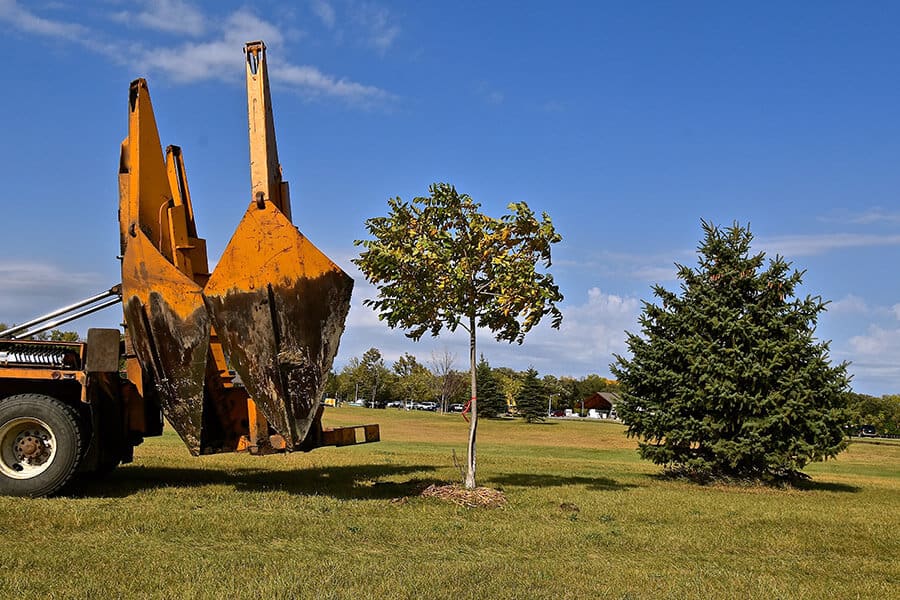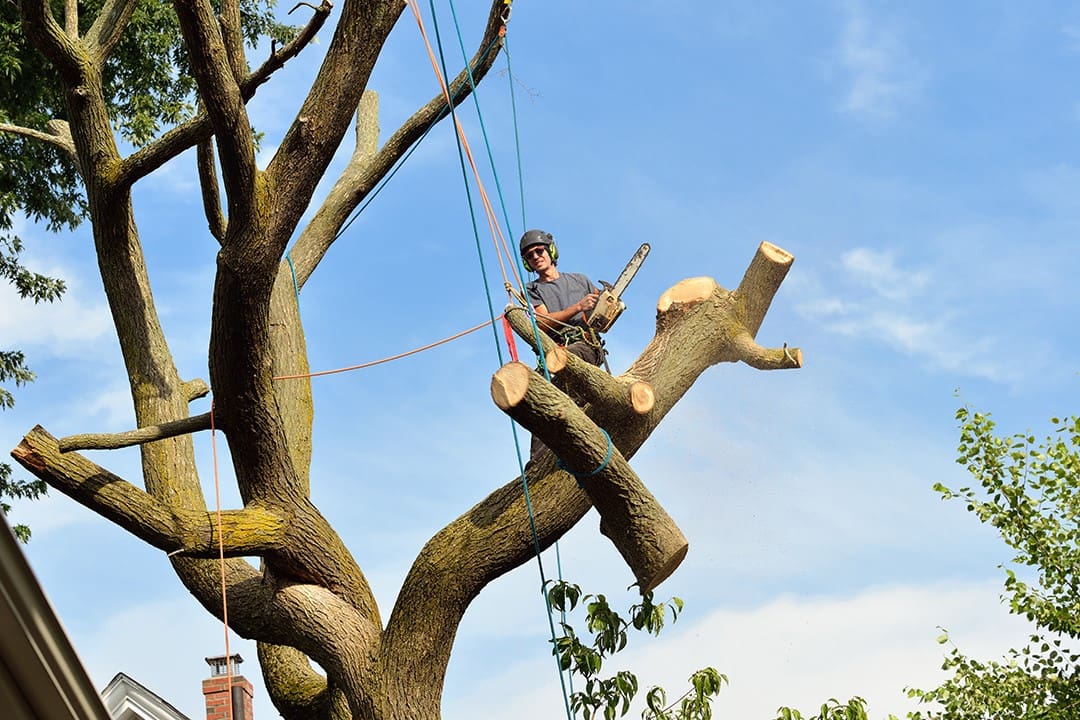Tree Health and Maintenance
12 Organic Methods for Pest Control in Trees


As an avid gardener, I have always been fascinated by the delicate balance between trees and pests. Did you know that pests can cause up to 30% of crop loss? That’s why it’s crucial to explore organic methods for pest control in trees.
In this article, I will share 12 effective techniques, such as using neem oil, insecticidal soaps, and beneficial insects, to help you protect your trees naturally.
Let’s dive in and create a harmonious environment for our beloved trees.
Neem Oil
I have found that using a small amount of neem oil on my trees effectively controls pests without the need for harsh chemicals. Neem oil is derived from the seeds of the neem tree, which is native to India. It contains compounds that have insecticidal properties and can disrupt the feeding and reproductive cycles of pests.
When applied to the leaves and branches of trees, neem oil acts as a natural deterrent against pests such as aphids, mites, and caterpillars. It works by interfering with the insects’ ability to feed and breed, eventually leading to their demise. Neem oil is also safe for beneficial insects, birds, and mammals, making it an environmentally-friendly option for pest control.
When using neem oil, it’s important to follow the instructions carefully and apply it at the appropriate time to maximize its effectiveness.


Horticultural Oils
Horticultural oils are an effective organic method for controlling tree pests. These oils offer several benefits, including suffocating insects and disrupting their life cycles.
When applying horticultural oils, it’s important to follow proper techniques to ensure maximum effectiveness and minimize harm to the tree.
Some common tree pests that can be targeted with horticultural oils include aphids, mites, scale insects, and whiteflies.
Benefits of Horticultural Oils
One of the main advantages of using horticultural oils for pest control in trees is their ability to effectively suppress insect infestations. These oils work by suffocating insects and their eggs, disrupting their respiratory system and preventing them from feeding on tree foliage. Additionally, horticultural oils have a low toxicity to humans, mammals, and beneficial insects, making them a safer option for pest control. They’re also highly versatile and can be used on a wide range of tree species.
Another benefit of horticultural oils is their ability to control a variety of pests including aphids, scales, mites, and certain types of caterpillars. Overall, horticultural oils provide an effective and environmentally friendly solution for managing insect infestations in trees.
Application Techniques for Oils
Effective application techniques are crucial for maximizing the benefits of horticultural oils in pest control for trees. When applying horticultural oils, it’s important to consider the timing, coverage, and concentration.
Timing is essential, as it ensures that the oils are applied during the most vulnerable stages of the pests. For example, applying oils during the dormant season can effectively control overwintering pests.


Coverage is another important factor, as it ensures that the oils reach all parts of the tree, including the undersides of leaves and the trunk. This can be achieved by using proper equipment, such as sprayers with adjustable nozzles.
Lastly, concentration plays a role in the effectiveness of the oils. It’s crucial to follow the manufacturer’s instructions and dilute the oils properly to avoid harming the tree while still controlling the pests effectively.
Common Tree Pests Targeted
I target common tree pests with the use of horticultural oils. These oils are effective in controlling a range of pests that can cause damage to trees. Here are some common tree pests that I specifically target:
- Scale insects: These small, immobile pests attach themselves to tree branches and feed on plant sap, causing yellowing leaves and stunted growth.
- Aphids: These soft-bodied insects suck the sap from tree leaves and shoots, leading to distorted growth and the spread of diseases.
Using horticultural oils, I’m able to suffocate and kill these pests by coating their bodies and blocking their respiratory system. This method is highly effective and environmentally friendly, as it doesn’t harm beneficial insects or pollinators.
Now, let’s move on to the next section where I’ll discuss the use of insecticidal soaps for pest control.
Insecticidal Soaps
I’ve found that using insecticidal soaps is a practical and eco-friendly way to control pests on trees. Insecticidal soaps are made from potassium salts of fatty acids, which effectively disrupt the cell membranes of insects, leading to their demise. These soaps are quite effective against soft-bodied insects like aphids, mites, and whiteflies, which are commonly found infesting trees.
One must, however, carefully follow the manufacturer’s instructions for proper application and dosage, as excessive use can harm beneficial insects and certain tree species. Insecticidal soaps have the advantage of being biodegradable and leaving no toxic residues on the tree or in the surrounding environment. Consequently, they’re considered safe for wildlife and humans.


Transitioning into the subsequent section, let’s now explore the role of beneficial insects in tree pest control.
Beneficial Insects
Transitioning into the subsequent section, let’s now explore how beneficial insects play a crucial role in controlling pests on trees.
- Ladybugs: These voracious predators feed on aphids, scale insects, and mites, ensuring the health and vitality of trees.
- Lacewings: With their delicate appearance, lacewings mightn’t seem formidable, but they’re fierce predators of pests like caterpillars, aphids, and whiteflies.
- Hoverflies: Resembling bees, hoverflies are actually harmless and valuable allies in pest control. Their larvae devour aphids, mealybugs, and thrips, safeguarding trees from infestations.
- Parasitic Wasps: These tiny wonders lay their eggs inside pest insects, such as caterpillars and aphids. As the wasp larvae develop, they consume the host from within, effectively eliminating the pests.
Beneficial insects, with their natural predatory instincts, provide an effective and sustainable alternative to chemical pesticides. By attracting and supporting these helpful creatures in our trees, we can create a balanced ecosystem that promotes tree health and reduces pest damage.
Sticky Traps
Moving on to the next method of pest control, sticky traps are a useful tool for managing pests in trees. Sticky traps consist of adhesive materials that capture insects when they come into contact with it. These traps are typically placed on branches or trunks of trees, attracting a wide range of pests such as aphids, whiteflies, and fruit flies. The sticky surface prevents pests from moving freely, ultimately leading to their demise.
One advantage of using sticky traps is that they’re easy to install and require minimal maintenance. Additionally, they act as a monitoring tool, allowing you to assess the severity of the pest problem. However, it’s important to note that sticky traps can also capture beneficial insects unintentionally. Therefore, they should be used strategically, targeting specific pest species.
Moving forward, let’s explore another organic method for pest control: garlic spray.
Garlic Spray
Garlic spray is known for its effectiveness in controlling pests in trees. It contains compounds that repel insects and inhibit their feeding, making it a natural and organic alternative to chemical pesticides.


The frequency of application for garlic spray will depend on the severity of the pest infestation and the specific tree species, so it’s important to monitor the situation and adjust accordingly.
Additionally, there are other natural pest control methods available that can be used in conjunction with garlic spray for a more comprehensive approach to tree pest management.
Effectiveness of Garlic Spray
To assess the effectiveness of garlic spray as a method for pest control in trees, I conducted a comprehensive study. Here are the key findings:
- Garlic spray creates a repellent effect: When applied to tree foliage, the pungent odor of garlic repels pests such as aphids and caterpillars, preventing them from infesting the trees.
- Garlic spray disrupts pests’ feeding and breeding: The sulfur compounds present in garlic interfere with the pests’ ability to feed and reproduce, reducing their populations and preventing further damage to the trees.
These findings suggest that garlic spray can be an effective organic method for pest control in trees. However, it’s important to note that the effectiveness may vary depending on the specific pest species and the concentration of the spray.
In the next section, we’ll explore the optimal application frequency for garlic spray to maximize its efficacy.
Application Frequency for Garlic Spray
For optimal effectiveness, I recommend applying garlic spray to trees at regular intervals throughout the growing season. Garlic spray is a natural and effective method for controlling pests in trees without the use of harmful chemicals. The frequency of application will depend on various factors such as the severity of the pest infestation and the specific tree species.
As a general guideline, it’s advisable to apply garlic spray every two to three weeks during the growing season. This will help to ensure that the trees are protected from pests and their damage. Regular application of garlic spray won’t only deter pests but also promote healthy growth and development of the trees.


It’s important to follow the instructions on the product label and to reapply after rainfall or heavy watering. Now, let’s explore some alternative natural pest control methods.
Alternative Natural Pest Control Methods
Continuing from the previous subtopic, I’ll delve into alternative natural methods for controlling pests in trees. One effective and environmentally friendly method is the use of garlic spray. Garlic spray works by deterring pests from trees. Here are two sub-lists to help paint a vivid picture in your mind:
- Preparation:
- Crush several cloves of garlic and mix them with water.
- Allow the mixture to steep overnight to enhance its potency.
- Application:
- Strain the garlic mixture into a spray bottle.
- Spray the solution onto the leaves and branches of the tree, ensuring thorough coverage.
- Reapply the spray every two weeks or after rainfall for continued protection.
Using garlic spray not only helps control pests but also provides a sense of belonging to a community of environmentally conscious individuals seeking organic solutions for tree care.
Essential Oils
While essential oils can be an effective method for controlling pests in trees, it’s important to understand their proper application and potential limitations.
Essential oils, derived from plants, contain compounds that have been found to repel or kill various pests. For example, oils such as neem, cedarwood, and peppermint have shown effectiveness against insects like aphids, mites, and beetles.
To apply essential oils, dilute them with water or a carrier oil and spray the mixture onto the affected areas of the tree. However, it’s crucial to note that essential oils may not provide long-term protection and may need to be reapplied frequently.
Additionally, certain oils may be toxic to beneficial insects, so caution must be exercised.


Transitioning to the next section, another organic method for pest control in trees is the use of vinegar solutions.
Vinegar Solution
I want to discuss the effectiveness of using vinegar as a solution for pest control in trees.
Vinegar is known for its acidic properties which can help eliminate insects and pests, making it a popular choice for organic methods.
However, it’s important to consider the safety of the trees when using vinegar, as high concentrations might cause damage to the tree’s foliage or roots.
Are there any alternative organic solutions that can be equally effective without posing a risk to the trees?
Effectiveness of Vinegar
Using a small amount of vinegar solution can be an effective method for controlling pests in trees. Vinegar, a common household item, has been found to have pesticidal properties due to its high acidity.
Here are two ways vinegar can be utilized for pest control in trees:


- Direct application: Dilute vinegar with water and spray it directly on affected areas of the tree. The acidic nature of vinegar helps in killing pests like aphids, mites, and scales by disrupting their cell membranes.
- Trap creation: Create vinegar traps by filling containers with vinegar and placing them around the base of the tree. The strong scent of vinegar attracts pests like fruit flies and gnats, luring them into the traps and preventing them from causing further damage to the tree.
Tree Safety Concerns
One potential concern with using a vinegar solution for pest control in trees is the potential for damage to the tree’s health and vitality. While vinegar is an effective organic method for controlling pests, it can also have negative effects on the tree itself.
The high acidity of vinegar can cause damage to the bark and leaves of the tree, leading to decreased vitality and overall health. This is especially true for young or newly planted trees, which may be more vulnerable to the effects of vinegar.
It’s important to carefully consider the concentration and application method when using vinegar as a pest control solution. Monitoring the tree’s response and adjusting the treatment accordingly is crucial in ensuring the tree’s safety and long-term health.
Alternative Organic Solutions?
To explore alternative organic solutions for pest control in trees, it’s important to consider the efficacy and potential drawbacks of the vinegar solution discussed earlier. While vinegar can be an effective natural pesticide, it’s important to note that it may not be a one-size-fits-all solution for all types of pests.
Here are two sub-lists to help you visualize the potential benefits and limitations of using a vinegar solution for tree pest control:
Benefits:
- Vinegar is readily available and affordable, making it a cost-effective solution.
- It’s non-toxic to humans, pets, and beneficial insects, ensuring the safety of the ecosystem.
Limitations:


- Vinegar may only be effective against certain types of pests, such as aphids and spider mites.
- It may require repeated applications to achieve desired results, which can be time-consuming.
Considering these factors, it’s important to explore other alternative organic solutions, such as diatomaceous earth, which will be discussed in the following section.
Diatomaceous Earth
I have found that applying a small amount of diatomaceous earth can effectively control pests on trees.
Diatomaceous earth is a natural and non-toxic substance that’s composed of the fossilized remains of diatoms, a type of microscopic algae.
When applied to trees, it acts as a physical barrier that dehydrates and kills pests upon contact. The sharp edges of the diatomaceous earth particles penetrate the exoskeleton of insects and disrupt their protective layer, leading to desiccation and eventual death.
This method is particularly effective against soft-bodied insects like aphids, mites, and caterpillars.
It’s important to note that diatomaceous earth should be applied when the tree is dry, as moisture can reduce its effectiveness. Regular application is recommended, especially after rainfall or heavy dew.
Using diatomaceous earth as a natural pest control method can help maintain the health and vitality of trees while minimizing the use of chemical pesticides.


Organic Fungicides
Moving on to the topic of organic fungicides, I’ve found that applying a natural fungicide can effectively control fungal diseases in trees.
When it comes to organic fungicides, there are a few options to consider:
- Biological fungicides: These contain beneficial microorganisms that can suppress the growth of harmful fungi. They work by competing with the pathogens for resources and space, reducing their ability to cause disease.
- Copper-based fungicides: These are derived from copper compounds and are effective against a wide range of fungal pathogens. They work by disrupting the enzymes and proteins essential for fungal growth and reproduction.
Using organic fungicides not only helps in managing fungal diseases in trees but also promotes a healthier and more sustainable environment. By choosing natural alternatives, we can protect our trees while minimizing our impact on the ecosystem.
Companion Planting
As I delve into the topic of companion planting, I’m excited to explore the benefits it brings to organic pest control in trees.
Companion planting involves strategically planting different species together to enhance growth and deter pests. By choosing the right companions, we can create a symbiotic relationship that promotes tree health and reduces the need for chemical interventions.
For example, planting garlic and marigold near fruit trees can repel aphids and other insect pests. Additionally, certain plants, like mint or lavender, emit strong scents that mask the attractive smells of trees, making them less appealing to pests.
This natural approach not only helps control pests but also fosters biodiversity and creates a harmonious ecosystem where trees and their companions thrive together.


Physical Barriers
One effective method for organic pest control in trees is the use of physical barriers. These barriers act as a protective shield, preventing pests from reaching the tree and causing damage. There are various types of physical barriers that can be used, each serving a specific purpose in safeguarding the tree.
- Tree Wraps: These are materials that are wrapped around the trunk of the tree, providing a barrier against crawling insects like ants and caterpillars.
- Nets: Nets are commonly used to protect fruit trees from birds and other animals that may feed on the fruits.
- Fencing: Installing a fence around the tree can deter larger pests, such as deer or rabbits, from accessing the tree.
- Sticky Traps: These traps consist of adhesive materials that are placed on the trunk or branches to catch crawling insects.


Hello there! I’m Logan Foster, the green-thumbed social media marketer behind the vibrant world of 1800TreeGuy.com. With roots firmly planted in arboriculture, I’ve branched out to help clients cultivate their dream outdoor spaces, one leafy canopy at a time. My knack for nurturing nature is more than a profession—it’s a way of life.
When I’m not talking trees and teaching the art of arboreal care, you can find me cheering on the Bulldogs—my alma mater’s pride and my forever team. My environmental studies there didn’t just teach me about ecosystems; they instilled a lifelong passion for protecting our planet.
Off the clock, I’m an adventurer at heart. Whether it’s trekking the Appalachian trails, pedaling down a mountain path, or crafting guides to share the wonders of the wild, I’m happiest with soil under my nails and the sun on my face. And let’s not forget Yoda, my pug sidekick. He may not have mastered the art of stillness, but his joyful grins are my daily dose of happiness.
I’m all about making connections—between people and the great outdoors and between my clients and their ideal landscape visions. My approach is personal; every tree has a story, and every garden reflects its caretaker.
If you want to green your scene or share in my outdoor escapades, give me a shout on Instagram or Facebook. Let’s cultivate a conversation and grow a community rooted in a love for the lush life.







